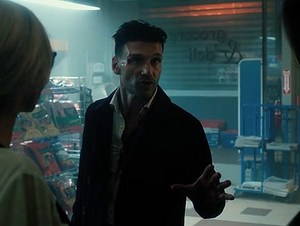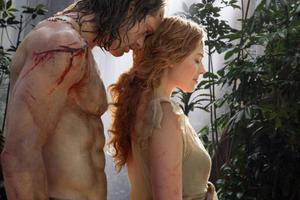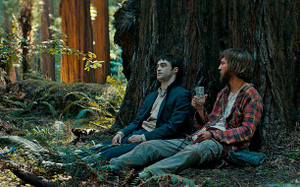
Ruby Barnhill and Mark Rylance in The BFG
Friday, July 1, 10:45 a.m.-ish: My latest quadruple-feature begins with The BFG, and the movie is a bit of a BFD, because it’s been nearly five years since Steven Spielberg directed anything a little kid might conceivably want to attend. (And even that 2011 release was The Adventures of Tintin, so, you know, it’s actually been more than five years.) But even though the crowd I’m with is barely deserving of the term “crowd” – it’s merely a couple-dozen tykes accompanied by taller chaperones – you can tell that this gentle, charming adaptation of Roald Dahl’s novel is working for them, because they’re unusually quiet during Spielberg’s many moments of lovely stillness, and they really dig the fart jokes. And hoo-boy are there fart jokes.
The BFG is all about an orphan (Ruby Barnhill’s Sophie) who becomes the pal and ally of a Big Friendly Giant (the motion-captured Mark Rylance), and when I say “all,” I mean all; beyond the subplot involving some brutish giants hungry for a human snack, Sophie and BFG hanging out is the whole shebang. Happily, especially given Rylance’s participation, that proves to be just enough. The CGI isn’t always convincing, yet Spielberg’s compositions and cinematographer Janusz Kaminski’s evocative shadows deliver true storybook enchantment, and there are ticklish images throughout, including the flipping of Sophie in a frying pan and BFG’s jarred, twinkling collection of children’s dreams. Rylance, meanwhile, does plenty of twinkling himself, but his portrayal is so humanely expressive that I almost never thought of Sophie’s towering buddy as a visual effect. As emotionally open here as he is reserved in Spielberg’s Bridge of Spies, and verbally masterful when reciting BFG’s litany of mispronunciations, the funny, moving Rylance performs motion-capture wonders that would make Andy Serkis himself doff his cap, and 11-year-old Barnhill, in her film debut, partners him with unaffected ease. I’ll admit, though, that I never enjoyed The BFG more than when it took an unexpected detour to Windsor Castle in its final quarter, granting its giant a meeting with Penelope Wilton’s Elizabeth II (and Rebecca Hall, too, that lucky dog) and treating the kids in the audience to the ne plus ultra in flatulence humor. I’m usually the first to bitch about the preponderance of fart gags in family entertainments, but shut my mouth: Watching the queen let loose with a loud, lengthy toot that flutters the palace tablecloths – what BFG calls a “whizzpopper” – damn near killed me. As BFG tells Sophie, “A whizpopper is a sign of true happiness.” In this case, yeah, it certainly is.

12:55 p.m.-ish: That’s the rough-estimate time I start watching writer/director James DeMonaco’s The Purge: Election Year. But its strangest detail lands at roughly 2:50-ish, when it’s revealed that in this ultra-violent funhouse version of our country, our national elections take place at the end of May. So give the movie an immediate 10 points for wish-fulfillment fantasy, because this year, I don’t know anyone who doesn’t wish that our presidential race weren’t already behind us. While we’re at it, grant DeMonaco’s second sequel several points more for intensity, cleverness, and juicy political metaphors, even while you dock it points for repetitiveness and bum dialogue. It’s again kill-or-be-killed time in America, with the franchise’s new entry focusing primarily on a presidential candidate (Elizabeth Mitchell) who’s running on an “eliminate the Purge” platform, and consequently becomes the murder target for those who’ll have the Purge pried only from their cold, dead hands. By now, we all know what we’re in for at these things. This typically grim outing, however, is a lot more fun than 2014’s The Purge: Anarchy, partly because of its uncomfortably on-the-nose echoes to our current electoral climate, and partly because it’s been designed as far more of an action thriller than a horror film; the series finally gives us some satisfying payback amidst all the wincing. It’s not a great time, but in its grubby, low-rent way, Election Year is still a very satisfying one, and the portrayals by Mitchell, Frank Grillo, Mykelti Williamson, Betty Gabriel, and Edwin Hodge are uniformly strong. Take it as a not-so-coded attack on Trump and/or endorsement of Hillary if you want. I was just relieved to spend time in a USA that seems a little less crazy than the one we’re in now.

2:55-ish: One of the first people we see on-screen in The Legend of Tarzan is Christoph Waltz, who arrives nattily attired in a white-linen suit and matching hat. If there’s an actor alive who needs this wardrobe equivalent of pure evil less than Christoph Waltz, I’ve yet to encounter him, and I mentally prepared for two hours of similar obviousness, rife as the film’s intro was with generic action choreography and talcum-powdered jungle warriors straight out of Apocalypto. But director David Yates’ take on the Edgar Rice Burroughs myth turns out to be much better than I expected. For one thing, we’re spared the traditional origin-story dullness, with the orphaned Tarzan’s upbringing among the apes, first encounter with Jane, and return to England doled out only sporadically in random flashbacks. For another, despite being set in the late 19th Century, Yates and screenwriters Craig Brewer and Adam Cozad keep the film’s sensibility distinctly modern, which helps dust the cobwebs off this particular Burroughs; Margot Robbie is terrific as an independent-spitfire Jane, the dialogue is brisk and snappy, and Samuel L. Jackson, bless him, is Samuel L. Jackson.
But the most enjoyable element of all is Alexander Sarsgård, and this is where all plans for an “objective” critical opinion fly right out the window, because I’m sorry: In his role as Tarzan, the guy is like walking porn. His early scenes as the civilized John Clayton are immensely smart, because you can still see the wild animal lurking beneath this British dandy in Sarsgård’s lowered gaze and alert yet slightly hunched stance, which makes him look like he’s always one second away from pouncing. (He’s also given a warm, beautiful moment nuzzling a lion’s head with his own, an image that few actors could pull off without the audience collapsing in fits of giggles.) Yet when the business of being Tarzan is called for and Sarsgård finally removes his shirt, it’s like Clark Kent unveiling the Superman logo under his white button-down or Bruce Banner morphing into the Hulk – a superhero has arrived, and it’s time to kick ass. Whether leaping off cliffs or taking on armies bare-handed or swinging on vines in scenes that recall the best of Sam Raimi’s early Spider-Mans, Sarsgård is a spectacularly charismatic star here, and his abs could be in deserved contention for next year’s visual-effects Oscar. (The man is so extraordinarily watchable and fit that he seems almost lab-designed to leave straight men and gay women stunningly confused.) Its star makes the already-engaging The Legend of Tarzan a complete blast, and he even pulls off the greatest Tarzan yell I’ve ever heard. Oh, wait – I forgot about Carol Burnett. Make that second-greatest.

4:50-ish: The movie day ends with Swiss Army Man, and before its opening credits appear, we see Paul Dano’s character preparing to hang himself. That’s sometimes how I feel by the time I reach my fourth movie in a quadruple-feature, but thankfully, from its first minutes, this weird little winner gives me no reason to feel morbid. I actually want to say as little about the experience as possible, because it’s such a unique, delicate, almost magical thing that describing its pleasures risks making the film sound either unbearably precious or just plain unbearable. It’s easy to offer a rough description of this oddity by directors Daniel Kwan and Daniel Scheinert (listed in the credits simply as “Daniels”), given that it’s basically Cast Away if Dano played Tom Hanks and Daniel Radcliffe played the volleyball. But as Dano’s Hank makes friends with, and makes excessive use of, the Radcliffe corpse that washes up on his deserted isle, you’re forced to admit that you’ve never seen anything quite like it. There are boner jokes and fart jokes (they’re not just for kids’ movies anymore!), and a drunken party that ends with Dano in drag. There’s Linklater-y philosophizing and Bergman-ian angst, and more than a few renditions of John Williams’ Jurassic Park theme song. There are musical montages and sing-alongs, and reminiscences about life, love, and masturbation. There’s Radcliffe, in a phenomenally witty physical and verbal turn, serving as a multipurpose drinking fountain, straight razor, shotgun, compass, and speedboat. And there is, above all, a transcendent exploration of loneliness and the measures we take to avoid it, delivered with exuberance and peerless performances and the Daniels’ fierce originality. True, the movie has three or four endings when one would suffice, but some of our most memorable dreams don’t seem to know when to end, either. I can’t wait to enjoy the dream of Swiss Army Man again.
6:40-ish: Four movies, and not a single one I left unhappy with, which is certainly a first. I think I should probably end on a high note and plan to make this my very last quadruple-feature. I’ll letcha know how that goes.










